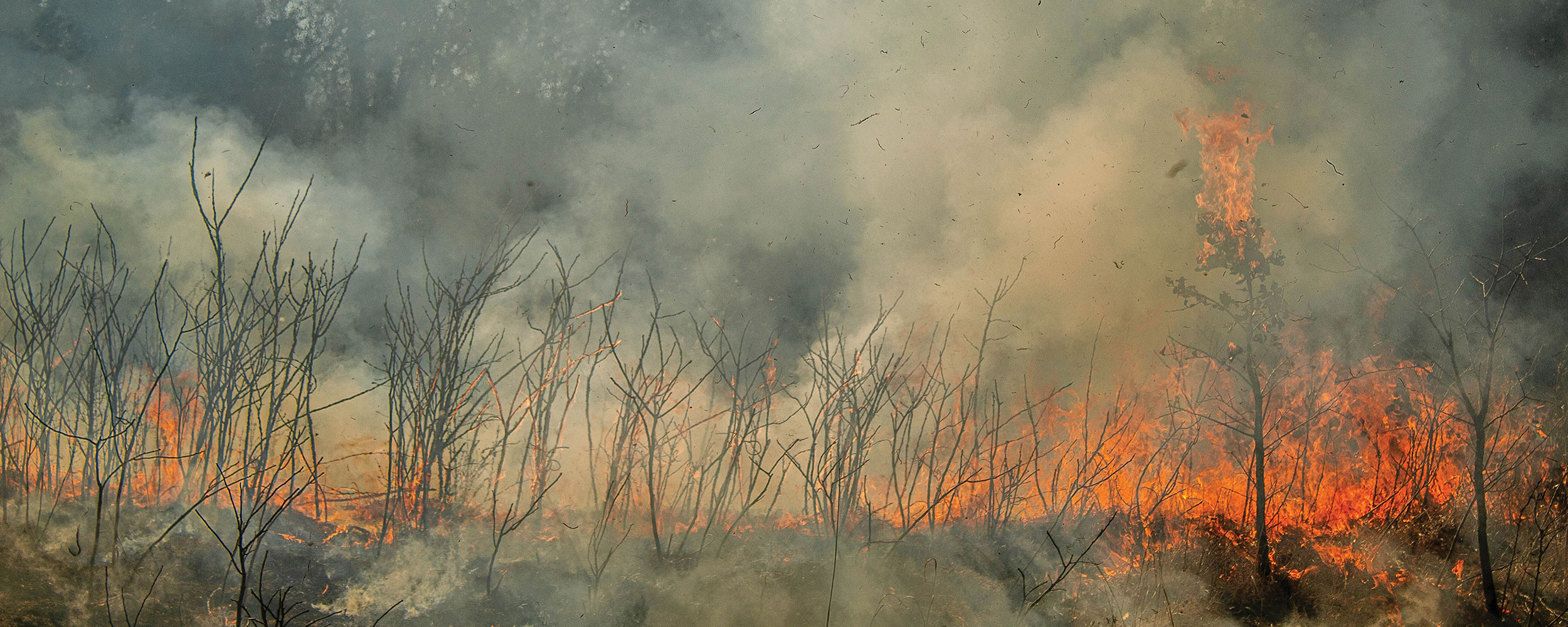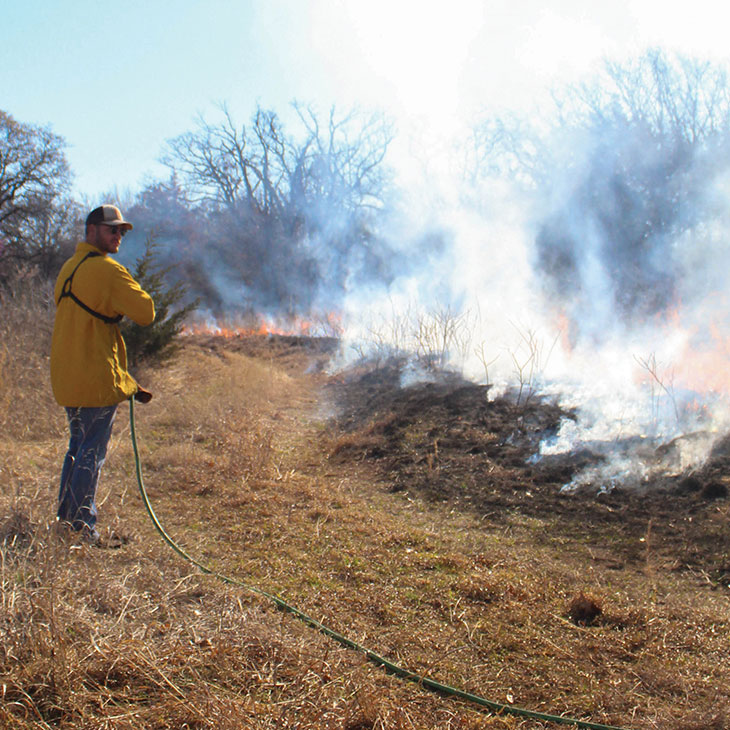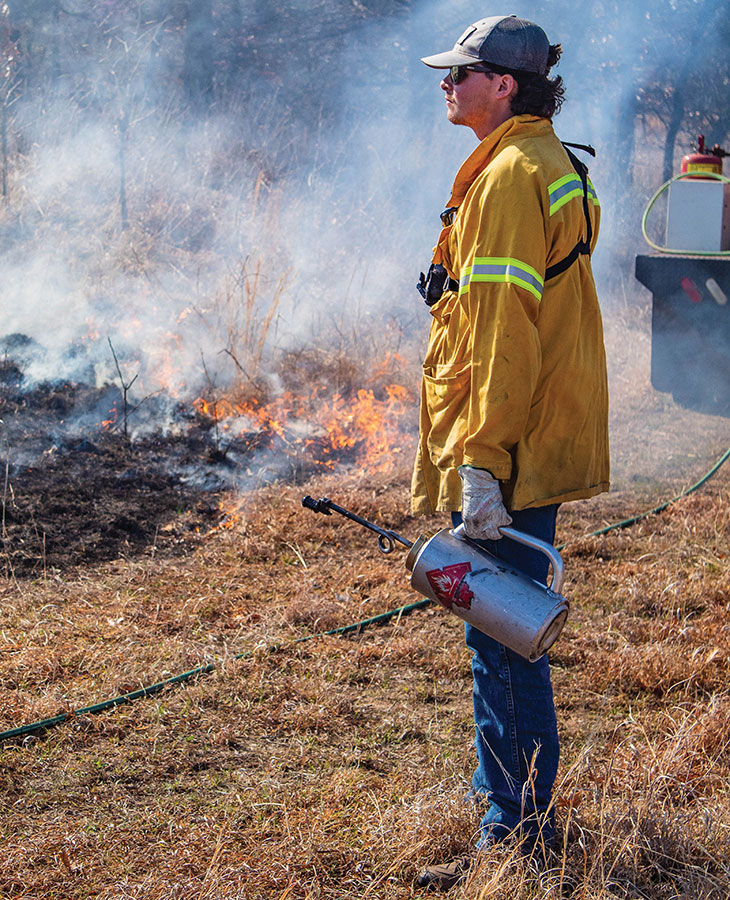
Up in Smoke
Thursday, June 10, 2021
Media Contact: Samantha Siler | Communications and Marketing Manager | 405-744-2977 | samantha.siler@okstate.edu
Oklahoma is known for its beautiful tallgrass prairies, but a hot history glows behind how this landscape came to be.
Natural fires played a vital role in the creation of the native prairies, scrublands and forests, according to Oklahoma State University Extension.
Today’s landscape is often threatened because of the lack of fires occurring throughout the state, said Aisha Sams, natural resource ecology and management master’s student.
Several things such as years of fire suppression, lack of burning and Eastern red cedar encroachment have contributed to the endangerment of Oklahoma’s ecology, Sams added.
“Fire is not a part of Western European culture,” Sams said. “There has been almost 200 years of fire exclusion in the area plus major changes since the 1950s.”

Fire was part of Native American culture, Sams said. Explorers such as Washington Irving and Thomas Nuttall found Native Americans using fire in what would become Oklahoma, according to OSU Extension.
“Without periodic fire to keep cedars and other woody plants in check, grassland ecosystems in Oklahoma will transition to forests and shrublands,” Sams said.
After the Dust Bowl leveled the farming lands of Oklahoma, federal conservation programs started mitigation to prevent another Dust Bowl from happening, Sams said. One of the prevention practices was planting Eastern red cedar trees as windbreaks and to help prevent soil erosion.
“The Eastern red cedar is native to Oklahoma but is also a volatile tree that catches fire easily,” Sams said. “Prescribed burns can control woody invasion into prairies.”
Eastern red cedar trees are considered hazardous fuels because of volatile oils that are stored in the trees, Sams said, and their structure allows fire to crawl from the grass to the tree’s top in what is called a fuel ladder.
The tree burns in a shower-like fashion and makes this tree hazardous to homeowners and firefighters alike, she added.
OSU Extension staff have use fire as an ecological driver to restore eco- systems and landscapes, according to OSU Division of Agricultural Sciences and Natural Resources.
Prescribed fires throughout the state are used to mitigate the Eastern red cedar trees and to improve the quantity and quality of forage in grazing lands, Sams said.
“Patch burning is the most cost-effective tool for wildfire prevention and brush management,” Sams said. “OSU Extension is pioneering this research and is doing a really good job of handling misconceptions.”
Patch burning is when small sections of pastures are burned without igniting the whole field, Sams said.
Sams said the positive outcomes from prescribed burning heavily outweigh the negatives. A lot of misconceptions still exist, however, because of safety and liability issues, she added.
“New technology and burn demonstrations have allowed for more fire to happen throughout the state,” Sams said. “The Wichita Mountains Wildlife Refuge is a good example of what fire can do for natural landscape.”
About 10 years ago, a major wildfire impacted the Wichita Mountains Wildlife Refuge. The U.S. Fish and Wildlife Service now emphasizes the use of prescribed fire for prevention and habitat management, Sams said. Prescribed fires are planned to meet specific management objectives, such as enhancing the habitat, she added.
Cole Fagen, NREM master’s student, has conducted research using drones to assist with prescribed burns.
Using drones is becoming increasingly popular throughout multiple agricultural practices, according to OSU Extension.
Using drones can make conducting prescribed fires safer, Fagen said. During a prescribed burn, multiple people are posted around the burn to monitor the live fire.
People will end up downwind of the fire right in the line of the smoke, Fagen said. Smoke can aggravate breathing and eyesight among other things, he added.
“This person does a lot of what we call ‘eating smoke’ when they’re on that job,” Fagen said. “The drone has helped eliminate this person eating smoke throughout the day.”

Fagen said the drone he uses has two cameras: a regular conventional camera and an infrared camera that can detect heat signatures.
The infrared camera can see through the smoke and help see where the fire might get away from the burn area, he said.
The drone also allows the operator to see how fast and in what direction the fire is moving.
“Using drones for prescribed fire is not perfect,” Fagen said. “Operating the drone is a one-person job, and you really have to know what you’re looking at.”
The drone can replace three or four people at a prescribed burn and will be useful technology for the future of fire, Fagen said.
Fire is crucial to the health of the ecology in Oklahoma and drones allow prescribed fire to become safer and more regular throughout the state, according to OSU Extension.
“Even with new technology like drones, prescribed fires are still a hands-on event,” said John Weir, associate Extension specialist in NREM.
Through outreach programs with landowners, agencies and students, OSU Extension provides information on prescribed fire. Weir said he has worked for 30 years to start more fires in Oklahoma — safely of course.
“We help people write burn plans, use tools, understand wind directions and more so they are able to host their own burns,” Weir said.
People who are interested in developing burn plans and learning more about what prescribed fire can do for their lands should contact their local county extension office, Weir said.
OSU Extension also offers a basic, online prescribed fire course through its website.
“I recommend people find someone who is burning and go help or watch,” Weir said. “People can be scared of fire, but experiencing it makes it less of a big scary monster.”
Story By: Katie Lacey | Cowboy Journal
